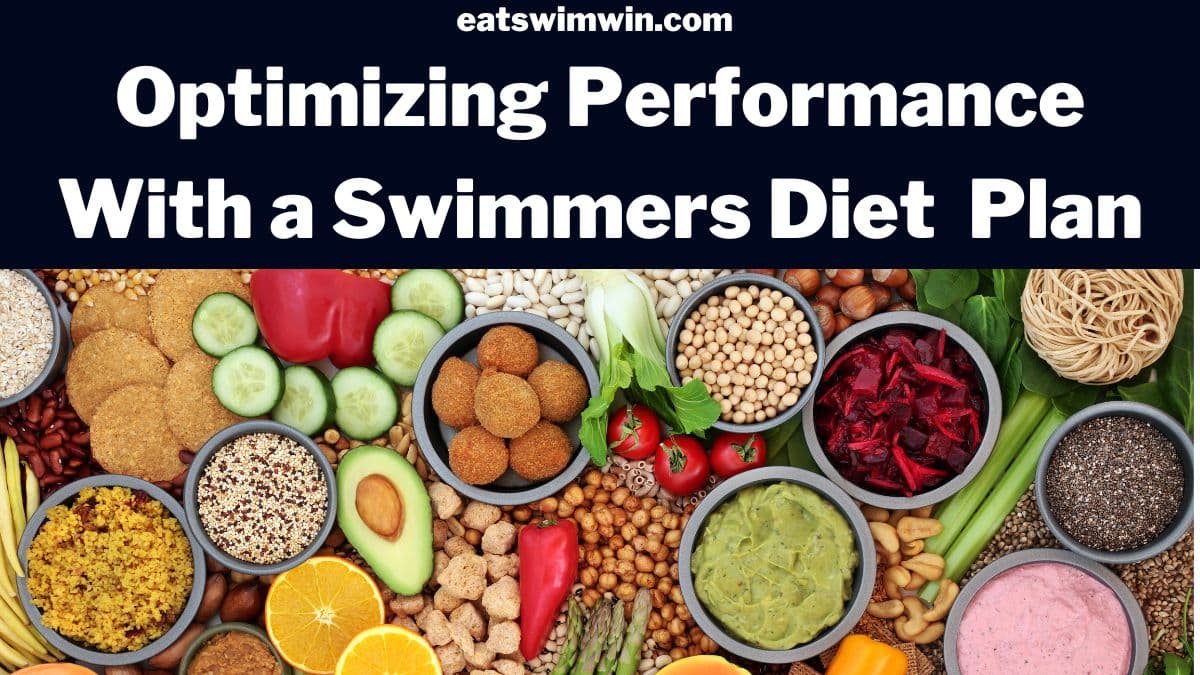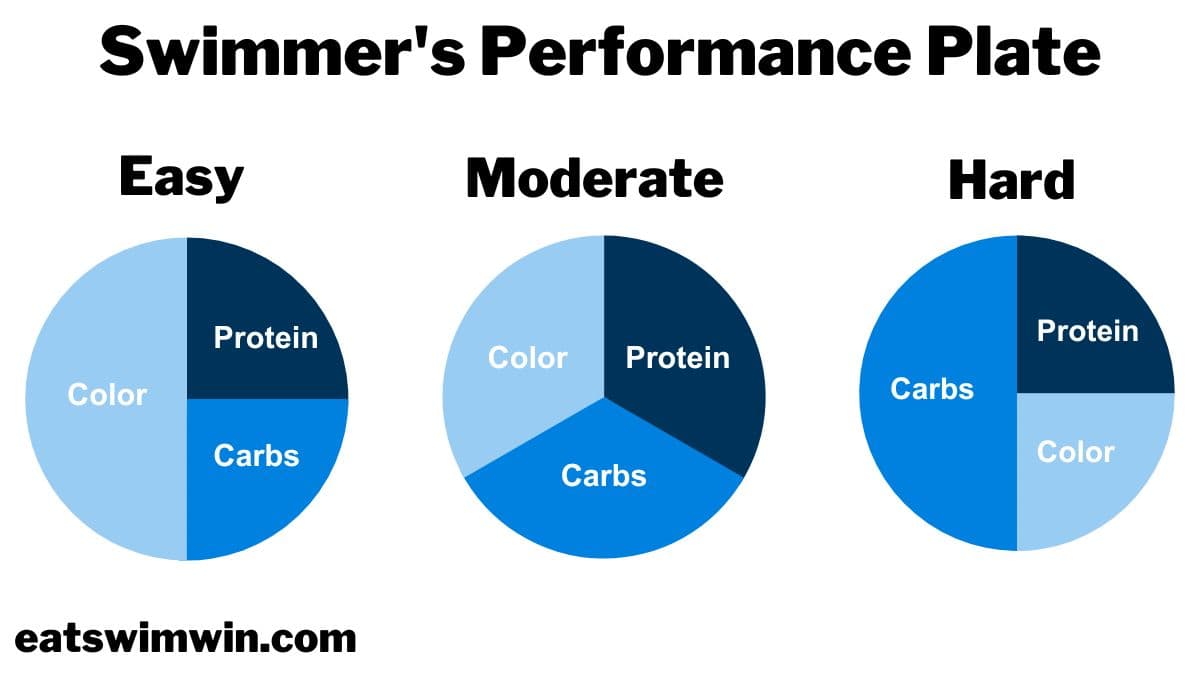
One of the easiest ways swimmers can combat fatigue, protect their immune system, and optimize performance is by creating a swimmer diet plan!
Are you feeling stuck and unsure how much to eat? Stick with us to learn how to build a swimmer’s performance plate personalized to your training load.
We will teach you how to create your own swimmer diet plan that doesn’t revolve around the removal of fun foods or labeling foods “good” or “bad.”
Our swimmer’s diet plan was created to educate and empower swimmers on how to fuel by incorporating more balance, variety, and moderation.
Keep reading for the ultimate swimmer’s diet plan.

Table of Contents
Unlike other sports, swimmer’s training sessions can last 2+ hours and occur twice a day. These practices are primarily in the pool and often with minimal breaks between sets making it difficult to refuel during training sessions.
Beyond that high volume of training, these intense workouts leave many swimmers with little to no appetite after practice.
This is because the hunger hormone, ghrelin “think grumbling ghrelins”, gets suppressed during exercise, thus blunting your appetite (1). However, swimmers still need to eat after a workout to recover even if they are not hungry!
Beyond those nutrition hurdles, swimmers are at a higher risk for developing disordered eating and eating disorders (2).
There are many factors that can cause or lead to any eating disorder. For swimmers, it is believed that wearing minimal clothing and tight swimsuits so frequently may be one factor.
Swimming also tends to thrive in a mentality that suffering is good and necessary in order to be the best in the sport. This can become a dangerous mentality for those who also struggle with mental health.
If you are currently in eating disorder recovery or feel that you are currently struggling with an eating disorder reach out for help!
Because of the high risk of disordered eating and the failure rate of restrictive diets, we do not recommend swimmers restrict calorie or food intake.
In our experience working one-on-one with swimmers, we have found that the most common nutrition problem is that swimmers do not eat enough.
This is why our swimmer’s diet plan focuses on adding to your plate versus what a swimmer “can’t or shouldn’t” have. With the high energy demands of swimming no foods are off limits.
However, we do recommend and support fueling with foods that make you feel good!
And keep in mind, Michael Phelps became the most decorated Olympic Athlete in the world eating 10,000+ calories a day consisting of fried egg and cheese sandwiches, chocolate chip pancakes, a pound of pasta, a whole large pizza, extra mayo on sandwiches, and more (3).
The media tends to demonize calorie-dense foods that athletes may need to meet daily energy requirements for high-level performance. Focus on eating enough; Michael Phelps won many gold medals while eating French toast, pizza, and much more!
Most swimmers do not eat enough carbohydrates which are key for optimizing performance, improving recovery, and where the bulk of a swimmer’s energy should come from.
Carbs are your brain’s main source of fuel, they also prevent your body from breaking down muscle and proteins for energy.
In season, competitive swimmers should aim for 7-12 g/kg of carbohydrates per day (4). For a 150lb athlete that is 476- 816 grams of carbohydrates per day. This can vary depending on your training load.
Try our swimmers’ carbohydrate calculator to calculate how much carbohydrates you may need each day and our pre-swim carbohydrate calculator to find out how many carbs you need before practice.
Check out our carbohydrate content of foods table to get an idea of good sources of carbs.

This plate is for the off-season. If your team takes a 2-week- 1-month break from training or you decide to take a break from hard intense training use this guide.
This is good for light days such as off-season, light walking, and easy yoga or stretch days.
This easy day plate is made up of:

This is for a light day of training and is likely not as common for competitive swimmers. This is for the swimmer who does a light 1-hour swim session
This can be a great plate model for athletes with a lighter base training load.
The moderate training plate is made up of:

This is how swimmers should fuel on race day and throughout the bulk of their training.
The hard day plate is for the competitive swimmer that trains >/= 2 hours per day. This plate guides swimmers to make nutrient-dense meals to help support peak levels of fitness. Half of your meals should be carbohydrates.
The hard training plate is made up of:

During high-volume and intense training seasons, swimmers will need to aim for 3 meals and 3 snacks per day or 4 meals and 2 snacks. Even a light snack is better than nothing at all!
The key to meeting your energy needs to optimize performance and prevent injury is eating frequently!
A well-designed swimmer’s diet plan is one where the swimmer feels fed and fueled. A swimmer’s diet plan must focus on consuming adequate nutrition!
Rather than focusing on media diet trends focus on what feels good and use the performance plate guide to guide your meal planning.
By incorporating sufficient carbohydrates, protein, healthy fats, fruits, vegetables, and fluids into their diet, swimmers can optimize their energy levels, muscle recovery, and overall health.
If you are feeling stuck consult with a registered dietitian for more personalized guidance.
Katie Schimmelpfenning RD, LD is a Registered Dietitian Nutritionist, USA Swim Coach, and former Division 1 swimmer. She helps competitive swimmers fuel and train to optimize performance, recover faster, and prevent injury! She is passionate about spreading evidence-based nutrtion tips to help swimmers across the globe.